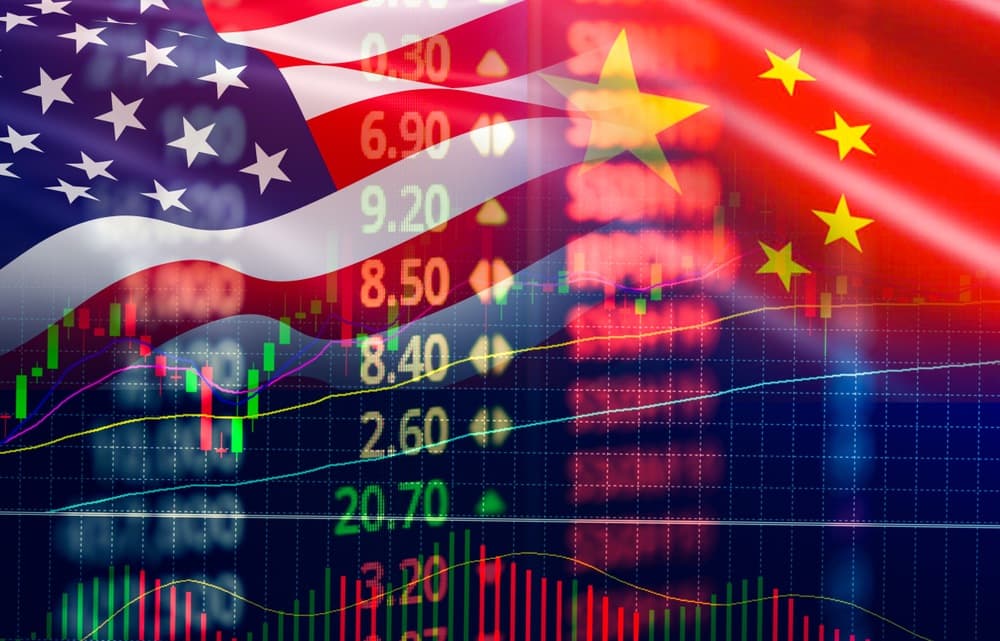Beneath the Surface
Twilight of an Empire Built on Post-War Credit
April 3, 2025 • 4 minute, 57 second read

“Five million manufacturing jobs were lost while racking up trade deficits of $19 trillion…”
– Donald Trump, during his Rose Garden “Liberation Day” speech
April 3, 2025 — In the aftermath of World War II, the United States inherited a world too exhausted to argue. Europe was rubble. Japan was radioactive. The Soviet Union had a big army and no grocery stores.
And so, without firing another shot, America took command — not through conquest, but through capital. The U.S. didn’t occupy the world. She underwrote it.
And as the rest of the world rebuilt, the U.S. went from being 80% of global manufacturing to about 16% today.
By and large, America outsourced its blue-collar workforce—the men and women behind the “Arsenal of Democracy” that won World War II—to become a more service-based economy, one that relied increasingly on debt to maintain its standard of living.
As we wrote in Empire of Debt, “We came, we saw, we borrowed.” That became our imperial motto.
Continued Below…
A place that could spark World War Three…Our newest video centers around a 97-mile stretch of water — a moat, of sorts — that guards the most sought-after treasure on the planet. “Whoever gains control of this treasure will likely rule the rest of the 21st century,” says top economist Andrew Zatlin. How valuable is the treasure within? “Profits could rival those of a (former) geopolitical treasure — as high as 2,055% over a six-year period,” predicts Mr. Zatlin. |
The Pax Americana era was born — not of iron and blood, but debt and dollars.
The U.S. dollar became the world’s reserve currency, backed not by gold after 1971, but by confidence and carrier groups. Through the Bretton Woods system, we institutionalized American economic supremacy. Through the Marshall Plan, we bought allies. Through NATO, we kept rivals on the defensive.
Call it idealism, or call it empire — it didn’t matter. As long as the credit held up, the Pax could continue.
Our multinationals expanded supply chains into China, Vietnam, and Mexico. Silicon Valley wrote the software.
Wall Street financed the risk. McDonald’s and Marvel made sure the culture followed. Meanwhile, the U.S. ran perpetual trade deficits and borrowed against the future like the repo man would never knock.
As we warned two decades ago: “An empire financed by debt rather than tribute is a curious thing… it depends on the kindness of strangers and the willingness of creditors.”
But by the 2010s, that kindness was wearing thin.
America had become a consumption colossus — addicted to cheap imports, distracted by imperial pretensions, and financially hollowed out.
The factories that once won wars were turned into parking lots and data centers. Entire towns rusted while Wall Street toasted global arbitrage.
The free market, it turned out, was great at creating wealth — just not evenly and not locally.
Enter Trump.
A real-estate tycoon with an instinct for leverage, he saw what the Ivy League economists couldn’t admit: globalism gutted the empire from within. Tariffs weren’t about fine-tuning trade deficits. They were about throwing a wrench into the post-war machine — forcing a national reckoning with our outsourced economy.
Trump’s strategy — if you could call it that — was a streetwise inversion of the Pax Americana formula. Instead of lending to secure influence, he threatened to cut off trade to reassert dominance. Think of it as the Empire of Debt’s margin call.
The world is no longer organized around American generosity or credibility.
We’re entering Pax Technica Multipolaris — a fractured landscape where blocs compete over chips, cables, AI engines, and the rocks beneath Greenland’s ice. The U.S. wants to re-industrialize. China is engineering an AI autocracy. Russia, as always, bets on energy and entropy.
This isn’t isolationism. It’s imperial triage. As Trump posted on Truth Social today amid the market turmoil:
“The operation is over! The patient lived, and is healing. The prognosis is that the patient will be far stronger, bigger, better, and more resilient than ever before. Make America great again!”
The phrase “leader of the free world” has lost its luster. America isn’t leading by moral example or strategic clarity. It’s clawing back relevance with tariffs, sanctions, and semiconductor subsidies. And the patient may yet die when its unpaid past debts come due.
As Empire of Debt warned, “Empires do not fall by invasion, they fall by financial suicide — by spending too much, borrowing too much, and believing too much in their own myths.”
That prophecy feels less like a warning now and more like a ledger entry — overdue, unpaid, and bearing interest. And President Trump’s moves to reverse this course may prove too little, too late.
Addison Wiggin
Grey Swan
P.S. Today, we just released our latest research on the growing “Chip Wars.” You can check it out here.
At their core, the Chip Wars are a geopolitical and economic power struggle over semiconductors — the tiny, unimaginably complex wafers that power everything from smartphones and satellites to drones, data centers, and nuclear weapons.
Semiconductors are the oil of the 21st century — but unlike oil, you can’t just drill for them. They require precision manufacturing, rare earth materials, cutting-edge design, and globalized supply chains stretching across politically unstable terrain. The most advanced chips are so complicated that a single fabrication plant (fab) can cost $14 billion and require components from a dozen countries.
The U.S., China, Taiwan, South Korea, Japan, and Europe are all scrambling to control — or at least not be cut off from — this critical supply. With rising tariffs, our research focuses on the best opportunities for U.S. investors today. It’s worth checking out, as is picking up some of the companies we’ve identified after today’s market discount.
Do you have any suggestions on content, angles, or ideas we should be pursuing? Please add your ideas or suggestions right here: addison@greyswanfraternity.com




